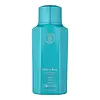What's inside
What's inside
 Key Ingredients
Key Ingredients

 Benefits
Benefits

 Concerns
Concerns

 Ingredients Side-by-side
Ingredients Side-by-side

Water
Skin ConditioningCetearyl Alcohol
EmollientDimethicone
EmollientStearamidopropyl Dimethylamine
EmulsifyingHydrolyzed Elastin
EmollientHydrolyzed Keratin
HumectantHydrolyzed Wheat Protein
Skin ConditioningCaulerpa Lentillifera Extract
Behentrimonium Chloride
PreservativeParfum
MaskingDipropylene Glycol
HumectantLactic Acid
BufferingAmodimethicone
Trehalose
HumectantGluconolactone
Skin ConditioningCocos Nucifera Oil
MaskingPotassium Chloride
Disodium EDTA
PEG-7 Propylheptyl Ether
Emulsion StabilisingCetrimonium Chloride
AntimicrobialSodium Sulfate
Methylchloroisothiazolinone
PreservativeMethylisothiazolinone
PreservativeWater, Cetearyl Alcohol, Dimethicone, Stearamidopropyl Dimethylamine, Hydrolyzed Elastin, Hydrolyzed Keratin, Hydrolyzed Wheat Protein, Caulerpa Lentillifera Extract, Behentrimonium Chloride, Parfum, Dipropylene Glycol, Lactic Acid, Amodimethicone, Trehalose, Gluconolactone, Cocos Nucifera Oil, Potassium Chloride, Disodium EDTA, PEG-7 Propylheptyl Ether, Cetrimonium Chloride, Sodium Sulfate, Methylchloroisothiazolinone, Methylisothiazolinone
Water
Skin ConditioningCetearyl Alcohol
EmollientCapryloyl Glycerin/Sebacic Acid Copolymer
Skin ConditioningDiheptyl Succinate
EmollientBehentrimonium Methosulfate
Parfum
MaskingGlycerin
HumectantPhenoxyethanol
PreservativeCetrimonium Chloride
AntimicrobialHydroxyacetophenone
AntioxidantGuar Hydroxypropyltrimonium Chloride
Skin ConditioningPersea Gratissima Oil
Skin ConditioningCitric Acid
BufferingMoringa Oleifera Seed Oil
EmollientHydrolyzed Quinoa
Skin ConditioningRosmarinus Officinalis Leaf Extract
AntimicrobialPanthenol
Skin ConditioningAloe Barbadensis Leaf Juice
Skin ConditioningLimonene
PerfumingWater, Cetearyl Alcohol, Capryloyl Glycerin/Sebacic Acid Copolymer, Diheptyl Succinate, Behentrimonium Methosulfate, Parfum, Glycerin, Phenoxyethanol, Cetrimonium Chloride, Hydroxyacetophenone, Guar Hydroxypropyltrimonium Chloride, Persea Gratissima Oil, Citric Acid, Moringa Oleifera Seed Oil, Hydrolyzed Quinoa, Rosmarinus Officinalis Leaf Extract, Panthenol, Aloe Barbadensis Leaf Juice, Limonene
Ingredients Explained
These ingredients are found in both products.
Ingredients higher up in an ingredient list are typically present in a larger amount.
Cetearyl alcohol is a mixture of two fatty alcohols: cetyl alcohol and stearyl alcohol. It is mainly used as an emulsifier. Emulsifiers help prevent the separation of oils and products. Due to its composition, it can also be used to thicken a product or help create foam.
Cetearyl alcohol is an emollient. Emollients help soothe and hydrate the skin by trapping moisture.
Studies show Cetearyl alcohol is non-toxic and non-irritating. The FDA allows products labeled "alcohol-free" to have fatty alcohols.
This ingredient is usually derived from plant oils such as palm, vegetable, or coconut oils. There is debate on whether this ingredient will cause acne.
Due to the fatty acid base, this ingredient may not be Malassezia folliculitis safe.
Learn more about Cetearyl AlcoholThis ingredient is a preservative, antimicrobial, and emulsifier. It is often used in cosmetics for its ability to cleanse, condition, and reduce static.
Cetrimonium chloride is a quaternary ammonium salt, meaning it has a water-soluble structure.
Parfum is a catch-all term for an ingredient or more that is used to give a scent to products.
Also called "fragrance", this ingredient can be a blend of hundreds of chemicals or plant oils. This means every product with "fragrance" or "parfum" in the ingredients list is a different mixture.
For instance, Habanolide is a proprietary trade name for a specific aroma chemical. When used as a fragrance ingredient in cosmetics, most aroma chemicals fall under the broad labeling category of “FRAGRANCE” or “PARFUM” according to EU and US regulations.
The term 'parfum' or 'fragrance' is not regulated in many countries. In many cases, it is up to the brand to define this term.
For instance, many brands choose to label themselves as "fragrance-free" because they are not using synthetic fragrances. However, their products may still contain ingredients such as essential oils that are considered a fragrance by INCI standards.
One example is Calendula flower extract. Calendula is an essential oil that still imparts a scent or 'fragrance'.
Depending on the blend, the ingredients in the mixture can cause allergies and sensitivities on the skin. Some ingredients that are known EU allergens include linalool and citronellol.
Parfum can also be used to mask or cover an unpleasant scent.
The bottom line is: not all fragrances/parfum/ingredients are created equally. If you are worried about fragrances, we recommend taking a closer look at an ingredient. And of course, we always recommend speaking with a professional.
Learn more about ParfumWater. It's the most common cosmetic ingredient of all. You'll usually see it at the top of ingredient lists, meaning that it makes up the largest part of the product.
So why is it so popular? Water most often acts as a solvent - this means that it helps dissolve other ingredients into the formulation.
You'll also recognize water as that liquid we all need to stay alive. If you see this, drink a glass of water. Stay hydrated!
Learn more about Water